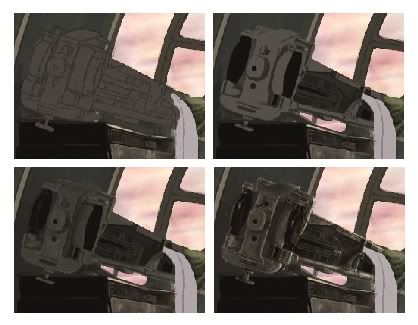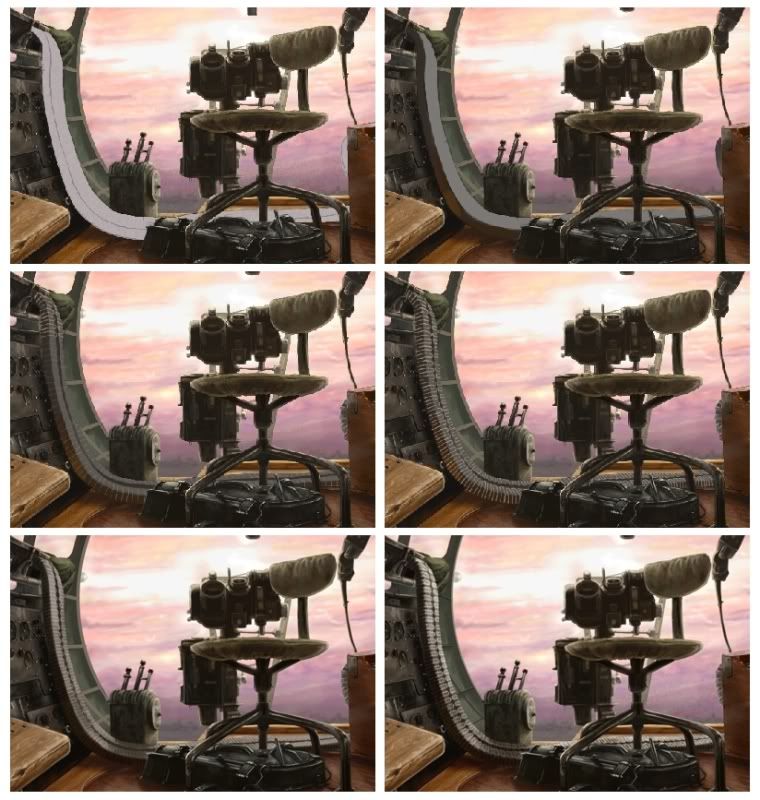The Empty Chair, the Bombsight
You know I'll never tire of drawing Flying Fortresses. ;) Anyway, I wanted to do something a little different this time: While my last B-17 painting, Flying Out of the Sun, was a moment frozen in time, this time around I wanted to try telling a story with little more than the objects that would normally be found in the nose, that might upon first glance seem to be simply an interior study. The "story" told by the picture was inspired by (but not necessarily based upon) those of 1st Lt Jack W. Mathis and 2nd Lt Robert Femoyer.
The Process
[The contrast, detail and quality of some of the pictures may differ. This is because I mostly took screenshots of my progress rather than save them as JPGs and then resize them (it saves time!), except when I wanted to show a WIP to a friend. Unfortunately, if you've done this before, you'll also know that whatever textural detail you originally saw while working zoomed out mysteriously gets lost when you save the full-sized picture and resize it. One thing that gets me hopping mad every time, and usually culminates in my throwing increasingly rough textures into the picture so that *some* of it gets preserved at least!]

I roughed out the layout of the bombardier's station on the nose, mostly with a high-opacity pen brush, but also with the circle tool since we know full well I can't draw curves for squat. No details - the cheek gun is little more than a cuboid, and I had only the vaguest notion of what a Norden bombsight looked like (going by this picture, the tail flukes of a handicapped whale).

With the guiding sketch down, I drew in the actual details with a much finer brush. At least this point you can tell the machine gun's a machine gun, and the bombsight now looks like a machine! (By this time I had found four or five excellent large pictures of them from different angles).

Just adding a layer of grey to see the foreground standing out from the outside environment. No, I don't know why.

My god, the hideous colours! AT this point, the colours are meant to do nothing more than separate different sections of the plane so that I can see enough to work on them later.

Look, there's a background! I started work on the fuselage, realised midway how much I hated the frame and stringers (which were done with the help of circle and line tools, in case you couldn't tell), decided to leave them be for the time being, and got to work on the wood instead. Much more fun. The picture was actually mirror imaged during the process so that I could comfortably paint the grain on the platform (being righthanded, I seriously cannot draw left-to-right diagonal lines to save my life. Not on digital media anyway, where you can't rotate the canvas the way you do paper...). The lighting was laid on top of the wood only after the texturing was completed.

The ammo box and table are now done, complete with imperfections and scarring. I wonder why the tabletop is
scorched...

Ditto the platform base, and what little of the floor that you can see.

Steps for painting the base of the bombardier's chair. In the case of deep shadows, I find it much easier to work from dark to light than the other way round. (Obviously). [The bombsight and bomb door control stand have been sneakily taking shape in the background as well.]

My linework is never necessarily indicative of the final layout. In this case, I decided that, with what I had in mind, it made no bloody sense for the back of the chair to face left, and moved it to the right instead. Thankfully, I almost always fully render objects partially hidden behind others, so there isn't a gaping hole to be fixed where the chair back used to be! The bombardier's panel equipment - now beginning to take shape - is another example of how things will sometimes change in my pictures. The canvas covering the gun mounts were a major annoyance, and even after throwing out a couple of versions and doing several reworks, I remained highly unhappy with them. It later turned out that I didn't even need the sodding things... but I'm getting ahead of myself. The shadows have also been banished from the fuselage. Good riddance, I say.

And the panel is more or less completed.

Progress shots of the Browning machine gun being painted in.

And - if you didn't think I was being insufferable enough - the ammunition belt taking shape in six steps. Not counting the steps I originally took in working in the painful details before realising they were much too big, and threw a fit, painted over everything and started again. To a certain good friend: sometimes there's nothing to do but to hold your breath and just throw it all out, neh? ;)

And as you can see in this WIP (which is actually the full-sized version of that last picture), I also decided to get rid of the original frame and stringers, and redo them.

More work turning the frames from what looks like curved string into frames running the circumference of the fuselage...

... And riveting the skin to the stringers etc...

Remember what I said about the gun mounts? Well, something at the back of my head kept telling me that what was being put on display today might not necessarily have been true at the time these fortresses saw battle. So I'd been browsing warbird forums for additional details, when I discovered: the mounts weren't covered back then. So it was out with the canvas and in with the mounts. I certainly didn't miss the bloody things, I tell you.

At the same time I came to the sinking realisation (thanks to same warbird forums) that... by the time B-17Gs rolled off the production lines, they'd stopped painting the insides to save both time and money (and weight!) - which makes sense, when you consider the fact that some of these bombers had a life expectancy ranging from days to weeks! [The interior photos taken during the period quite clearly showed naked aluminium.] And since I believe that to make an honest mistake is understandable, but to make one when you know better is irresponsible, I had to likewise change the fuselage. Most annoying rework I had to do for the entire painting.

A section of fuselage near the navigator's table has been torn away (based on photos of actual battle-damaged fortresses), the lamp has been twisted and broken off, and one earpiece of the headset has been torn loose - and, if you look carefully, you may or may not find bits of shrapnel around, among other things. With these final details in, the painting hopefully tells the story of a bombardier who was struck by fragments of an anti-aircraft shell and badly injured, but who nevertheless crawled back to his station, made the bomb run and delivered the payload before collapsing from his chair. (Whether or not he survived is open for speculation). I don't know if anybody will read the picture as such (or even see it as more than just an interior study); indeed, the friend I showed it to didn't notice the telltale details, which at least reassures me that the trail I left on the platform and various other pieces of furniture were not so blatant they caught the eye immediately!
------------------------------------
This picture has been something of a labour of love, painted with the help of a folderful of reference photographs, both those taken during wartime and those of restored Flying Fortresses. However, I am only human and am thus not infallible; if there's anyone watching me who is a serious B-17 enthusiast and knows their way around these birds, then I apologise in advance for any technical deficiencies, or anachronisms I may have inadvertently committed. There's only so much one can do.